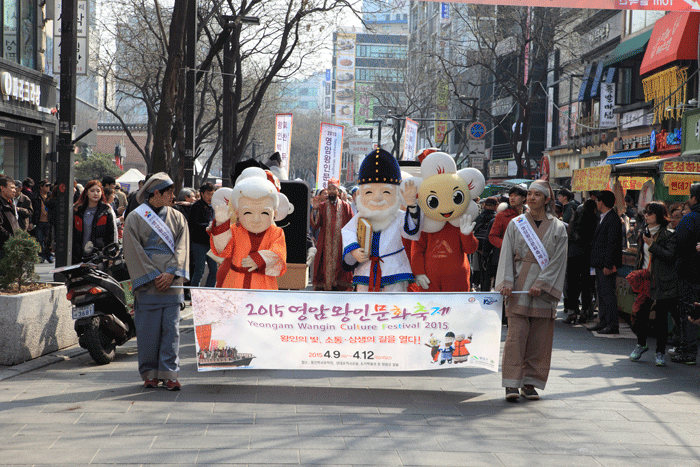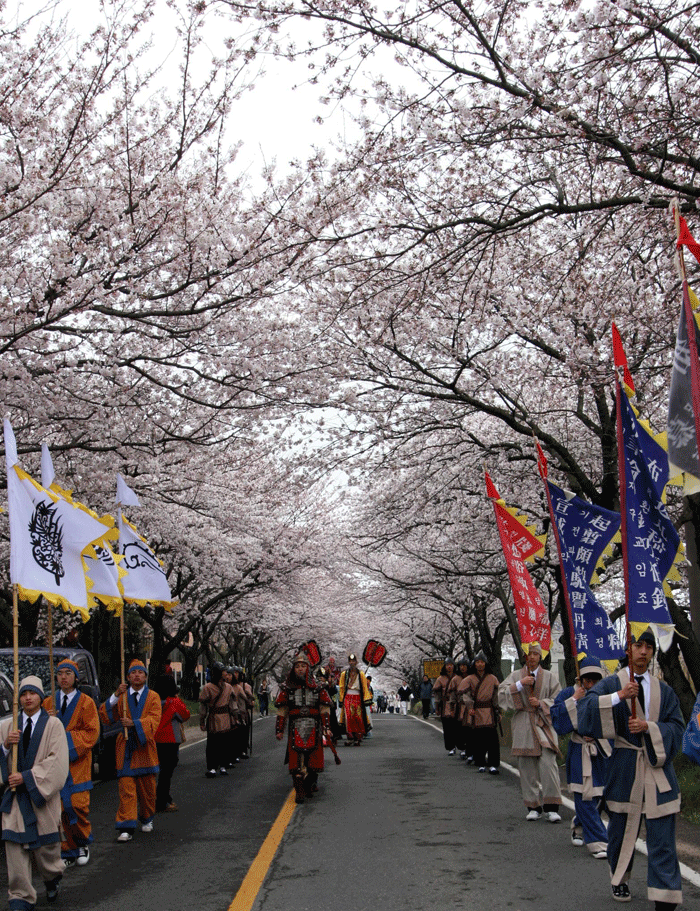In memory of distributing Korean culture to Japan in 3rd, 4th centuries
Mayor Jeon Dong-pyeong of the Yeongam County, near Gwangju, is hosting the 2015 Wangin Culture Festival in his country on April 9-10, 2015 in memory of the noted Korean scholar, Dr. Wangin, who spread Hanja, Chinese characters and classics, to Japan in the third century.
Dr. Wangin, or Wangin Baksa, visited Japan at the invitation of Emperor Ojin of Japan (15th Monarch of Japan) in the 17th Year of King Asin (AD 392 to 405) of Korea’s Baekje Dynasty, and spread in Japan the Confucian Classic (including Chinese characters), calligraphy, blacksmith, pottery, weaving and various other forms of art and craftsmanship in Japan.
This year marks the 50th anniversary of establishment of diplomatic relations with Japan, and it is all the more meaningful to host the Wangin Baekje Culture Festival.

A number of ambassadors are invited to attend the Festival visiting Yeongam by air and tour various historical and cultural sites in addition to attending the opening ceremony of the Festival.
The schedule for the ambassadors include a tour of the famous Dogap-sa Buddhist Temple and the Gichan Land health, amusement and resort venues?as well as attending the famous festival’s opening ceremony.
An estimated total 2,000 persons, many of them volunteers, are expected to take part throughout the event period to accommodate the visitors and provide them with various services, including baby cart service and wheelchair free rental for handicapped people.
Representative events take place at three major venues, namely the Wangin Baksa historical sites, Sangdaepo Historical Museum and Park and Pottery Museum in the Yeongam County.
The event schedule includes the following:
Gichan Musicarade featuring “Dr. Wangin goes to Japan,” Gichan Nanjang where KBS classic Korean music troupe will present special performances, Wangin Story Smart Grand Festival, Gichan Bus Tour and Gichan Food Land Festival.
The Wangin Culture Festival is in commemoration of the historical visit of the noted Baekje Korean Scholar Wangin Baksa to Japan in the 17th Year of King Asin (AD 392 to 405) of the Baekje Dynasty of Korea (BC18-AD660). Baksa means ‘a doctor’ or ‘a scholar.’
In recognition of the historical and cultural importance of the Wangin Culture Festival, the Central Government has designated the Festival as a Representative Culture Tourism Festival of the Republic of Korea.
The Wolchul-san National Park of the Republic of Korea in Yeongam County is noted for 40 kilometers of road with a line of cherry blossoms along both sides and this is one of the main venues where the Wangin Culture Festival is held.
In the Yeongam County of Jeollanam-do Province of Korea, where Wangin Baksa was born, a number of commemorative festivals are held in memory of Wangin Baksa. They include the Cherry Blossoms Festival as well as the Wangin Culture Festival which has become one of the Major Culture-Tourism Festivals of the Republic of Korea and designated as one of the Important Intangible Cultural Assets of Korea.
Wangin Baksa (or Dr. Wangin) was born in the Gurim Village of the Yeongam County of Jeollanam-do Province during the rule of King Geunchogo (?-375AD) of the Baekje Dynasty when the Kingdom was at the zenith of prosperity and cultural development. According to The Studies of the Ancient History of Korea by Lee Byung-do, a noted Baekje Scholar, Ajikgi, visited Japan with two horses on the instruction of King Geunchogo of Baekje and presented them to Emperor Ojin of Japan (15th monarch of Japan). Ajikgi then taught the Japanese people how to breed and rear horses.
Emperor Ojin of Japan learned that Ajikgi was very well versed in Confucian classics and appointed him the Teacher of Crown Prince Totochi.
When Ajikgi was readying for his return to Korea after his tour of duty in Japan had been over, Emperor Ojin had his own famed scholars of Japan (such as Arata Wake) accompany Ajikgi to Korea with a request to the Baekje King to send another highly learned scholar to Japan.

The Baekje King chose Wangin (then aged 32) and sent him to Japan with ten volumes of Noneo (Lunyu), the Analects of Confucius, and one copy of Cheonjamun (Qianziwen) containing 1,000 basic Chinese characters. As was briefly mentioned earlier, Wangin Baksa thus became the Teacher of Crown Prince Totochi of Emperor Ojin.
Wangin, at the age of only eight, entered the Munsanjae School located at the foot of the Wolchul-san Mountain in Yeongam and studied Confucian Classics and Buddhist scriptures. Wangin stood out in these studies and mastered the Five Books of Confucius at the age of 18.
Wangin accepted the offer of the King of Baekje and left Korea for Japan. In Japan, Wangin taught Chinese classics and history to the lords and subjects, and continued his own study of the Confucius.
The descendants of Wangin Baksa also lived in Kochi, Japan working at the Court as historians--greatly contributing to the development of ancient culture of Japan named the Asuka Culture .
In Kojiki, the famed History Book of Japan, the name of Wangin was listed as Wanikishi and identified as King Jogoju (Shokoshu) of Baekje. In another well-known ancient history book of Japan named Nihon Shoki, Wangin is listed as Wani.
The Baekje Kingdom at the time was continuously harassed by the invading forces of the neighboring Goguryeo Kingdom in Northern Korea and, in order to defend the country from Goguryeo, King Asin of Baekje established diplomatic relations with Japan and sent Crown Prince Jeonji to Japan. Seven years later, Emperor Ojin of Japan sent the Korean Crown Price back to Korea and asked King Asin to send a noted Korean scholar to Japan to help the development of culture in Japan.
Thus, Wangin left Korea using a boat from the Sangdaepo Port of the Yeongam County. Wangin then was 32 years old. Sangdaepo is a famous port of Southern Korea which was also used by noted Silla Dynasty Scholar Choe Chi-won when he left Korea for Tang China for academic studies.
In Japan, Wangin not only taught the Japanese people the Confucian classics but also various other art and handicraft skills, including pottery, blacksmith, weaving and roofing tile-making together with Korean handicraftsmen whom he had brought to Japan from Korea. The Japanese people are proud of the Asuka Culture. Wangin is the original creator of the Asuka Culture that flourished in Japan at the time.
Wangin Baksa died in Japan and was buried in a tomb located in Hirakatae in the Osaka City of Japan. The Tomb of Wangin was designated as the Local Cultural Asset Number 13 of the Osaka City in May 1938.
In Korea, the birth place of Wangin Baksa in the Seonggi-dong Village of Donggurim-ni in Gunseo-myeon, Yeongam County was developed into a Sacred Land and the Tablet and Portrait of Wangin are enshrined in a traditional Korean architecture built in his memory and honor. In early April every year, the Wangin Baksa Memorial Service is held at this shrine.

